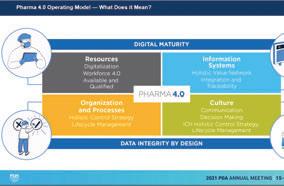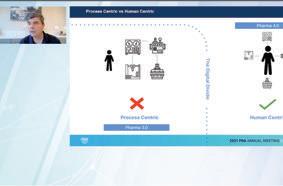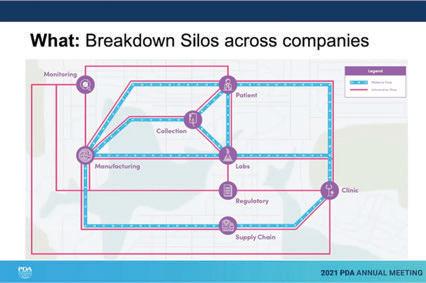
11 minute read
DIGITAL TRANSFORMATION
↙ Adoption of AI in validation and other processes, including data collection and management, can result in valuable predictive qualities within a manufacturing facility.
Data and AI Accelerate Digital Transformation in Pharma
MELISSA GRIFFEN, CONTRIBUTING EDITOR
1. Manufacturers must focus on replacing paper with data through digital transformation. 2. Starting small is the way to approach digital transformation, keeping the end state in mind. 3. Artificial Intelligence will allow for robust real-time processes and predictive qualities.
TOP THREE TAKEAWAYS
As the name implies, “Pharma 4.0” is Industry 4.0 applied to pharmaceutical manufacturing, which is the addition of cyber-physical systems to computerize manufacturing while focusing on the human element. The concept has been gaining traction in recent years and was a common theme in the 2021 Parenteral Drug Administration (PDA) Annual Meeting.
The four pillars of Pharma 4.0, as explained by Gilad Langer, Industry Practice Lead at Tulip Interfaces, a digital technology provider, are: • Resources • Information Systems • Organization and Processes • Culture
These pillars focus on digitization, digitalization, and the human element. Further, Pharma 4.0 allows for the democratization of technology. In other words, what once was available only to experts is now available to the general workforce. The shift to this democratization can be eased through the new generations entering the field, who are all but raised on technology, making them what Langer called “digitally native.” Yet, the pharmaceutical industry is not taking full advantage of these advancements.
One of the main facets of the Resources pillar is digital transformation which centers on real-time data and information to increase productivity, enable machine operators to do their jobs more efficiently, and further allow the use of predictive technologies, augmented reality (AR) and virtual reality (VR), Big Data, artificial intelligence (AI), and machine learning (ML). It allows for connectivity through integrated systems, equipment, people, and other software systems; real-time visibility into operations; transparency for quicker reaction time; and, at its highest levels, predictability and self-optimization in that the system can predict the outcome of a batch or machine’s performance and self-correct. In this kind of environment, apps, smart sensors, or the Industrial Internet of Things (IIoT) are used as a means of first capturing the data from the floor, which is then transferred to the cloud, available for use. (For more on predictive maintenance, see pp. 41.)
Replacing documents with data
Thus, a focus of digital transformation is replacing the use of paper as a means of data collection. Paper is cumbersome and
Insert text here...
↑ These pillars focus on digitization, digitalization, and the human element.


↑ Organization and Processes need to become digitally native, and continuous improvement is at the core of this transformation.
time-consuming, placing additional unneeded demands on the workforce, yet factories–and especially those in pharma–still rely heavily on its use.
Referencing the Pharma 4.0 pillars, Langer pointed out that digitally native workers come into the workplace only to be brought into a Culture which teaches them to use Organization and Processes that are centered on paper. This is a waste of ability to help transition into the digital era and serves only to create a workforce gap.
At the same time, digital transformation is not one large operational problem to be tackled at once, but rather is made up of a multitude of small changes facilities can make which don’t take as large of an investment to fi x, according to Langer. The Organization and Processes need to become digitally native, and continuous improvement is at the core of this transformation.
Langer envisions this process taking a number of years to fully accomplish, with one foot on each side of “the digital divide.” This paradigm shift to digital data will happen gradually, requiring the industry to switch from its current document mindset, and it is
Artifi cial Intelligence Implemented in Regulatory
Jerry Chapman, Senior GMP Quality Expert at Redica Systems (Redica), explained that meeting regulatory requirements and business demands is often hindered by the complexity of facilities, supply chains, products, and especially evolving regulations. Redica provides an integrated set of data inspection enforcement documents that includes all FDA inspected and registered sites since 2000.
By mining enforcement data, such as in 483 observations and FDA warning letter citations, companies can better understand and meet the changing expectation of regulatory agencies. Redica uses proprietary AI expert models, built using machine learning and honed by industry experts, to do the heavy lifting for companies, saving them time and helping them better meet their facilities’ needs.
The AI expert models are created to facilitate analyses which can then be used for (1) inspection preparation, (2) tracking and trending inspection observations, and (3) fi nding observations and citations “hiding in plain sight” within the defi ciency descriptions of warning letters.
An expert model cleans up documents, putting them through optimal character recognition and proofi ng them to give a company a proper data set. The documents go through processes that break sentences down into n-grams–or the continuous sequence of words–better allowing the AI to understand the content.
The n-grams are then organized based on the FDA’s six GMP classifi cation categories along with data integrity, which is becoming increasingly important. Running the expert model allows companies to fi gure out what is non-conforming in the facilities and why. Redica has expert models for medical devices, clinical trials, APIs, human cell and tissue/GTP, and more. Some of these models are still being tested.

↑ Unifi ed platforms would simplify the collecting and sharing of data between departments and companies and eliminate complex, redundant systems.
Value Drivers Enabled by Connected Quality Include:
+ Predictive quality and supply chain analytics + Improved QA/QC stage gate and release cycle time + Enhanced supplier risk management + Digitally enabled quality culture + Enterprise-wide process quality visibility + Accelerated internal and regulatory reporting
Data and Risk Management in the Drug Supply Chain
Problems occurring in the supply chain affect the rest of the chain downstream and can result in drug shortages. The disruptions caused by the pandemic only widened the supply chain’s gaping holes. Digital transformation, as aforementioned, makes data readily available, which allows for risk management, and must be supported by integrating emerging technologies and related implementation approaches to drive rapid transformation and equip teams for ongoing innovation. never too late to start.
“What we want to do is create digital content that is human-centric for one small problem at a time,” said Langer. He went on to explain a few examples applied with a set of technologies called no-code apps or digital content. “Basically, all of your engineers, all those who are within the operational domain of your manufacturing plant, can use something that feels like and looks like a PowerPoint to create these digital sets.” They do this by logging events, creating data sets that can then be stored in the cloud in a way that will allow advanced algorithms like AI and ML to use the data.
More sophisticated ways to capture data—such as work order terminals that interact with an ERP to get input on work orders on the fl oor, and batch processing and recording, capturing batch record data—can be used, though simple checklists on mobile devices, simple deviation/exception recording on a laptop or tablet, and especially digital logbook solutions are also eff ective.
Digital logbooks run operators through simple screens on interactive apps with built-in quality checks and built review-by-exception. Langer suggested incorporating digital logbooks as a simple way to introduce digital transformation to the fl oor along with batch records. Data entered in is displayed in tables, graphs, charts, and other familiar formats, which are easily consumed by advanced algorithms. This data is simple and transparent and does not require
sophisticated databases.
AI, Blockchain, and robotics are the most transformative technologies that promise to change the way businesses and industries operate, particularly in management of supply chain. These technologies help support adaptation to demand and performance fluctuation which can happen overnight and easily get out of control.
CGI, an IT and business consulting service firm, offers a unified platform powered by a concept called Connected Quality, intended to offer greater visibility with a real time wholistic view of the entire supply chain. This would allow a company to bring its supply chain management together and support predictive decision-making and advanced mitigation of issues.
Connected Quality is the concept of having unified, harmonized global systems and processes. It’s ensuring the right data is collected. An RPA platform is limited to having proper data sets that have been mastered and are consistent as RPA bots work off of repetitive data or administrative tests. Large, high quality data sets are required to apply ML or AI to the layer of your systems, so that the bot can learn properly and give best results.
Managing your data
Vasu Rangadass, CEO of software solution provider L7 Informatics (L7), Inc, agreed with Langer, that starting small is the way to approach digital transformation though the end state needs to be kept in mind. Otherwise, as Rangadass put it at the PDA event, the process will be like putting together a puzzle without knowing what it should look like in the end, which only wastes time and resources.
Rangadass went on to explain that digital transformation requires a clean set of data. The traditional way of collecting data is to gather it from all sources and put it into one single database as a system of reference. But this creates “digital silos,” which then require validation and as companies merge, are acquired, and receive new products, this leads to complications with outdated data. This results in high IT expenses as IT maintains various complex, redundant systems. Unified platforms would simplify the collecting and sharing of data between departments and companies and eliminate those complex, aforementioned redundant systems.
Unified platforms have common data models, codes, tooling, architecture, and a common business process that spans capabilities across departments and companies in order to provide greater process intelligence all from one system that offers the applications needed.
L7’s ESP software solution has taken on concepts from Robotic Process Automation (RPA) composable unified platforms with an FDA regulatory compliant framework, which is applicable to the manufacturing scene. Applying such a digital solution can take anywhere from three to nine months, said Rangadass, depending on the complexity of the process, the quality control (QC) process, and the manufacturing process. When a system has become digitized, the application speed increases. L7 customers tend to start the digitalization process with QC and batch records.
“We want to remove barriers to connectivity. We have connectors to 150 different wire process equipment, environmental monitoring systems, software systems, etc. These connectors play an important part, and we package them as part of the platform to reduce any kind of impedance for customers,” said Randagass. “While connectors are very easy and cheap to build, not having them in one place is a challenge, so we package all the connectors so customers can easily deploy the platform and that gives them contextualized data whether it’s environmental or from the wire process equipment.”
Validation and the regulatory aspect
L7’s efforts towards regulatory compliance with ESP span to its creation as a Good Manufacturing Practice (GMP)-compliant platform, which can be up to 80% validated, meaning that customers need only drop in their processing and validate the last 20%.
Langer further pointed out that if companies choose a vendor in the GMP space, their platforms will come pre-validated, and from there they could build on the platform with no-code apps. Validation for no-code is also different from software validation in that it must be validated based on intended use, as in the end: • The apps are instruments in processes for capturing data. • That data will prove the results, which further proves the companies are in control of the data and that they are complying.
Toni Manzano, CSO and Co-Founder of Aizon, an AI platform provider, added to this by explaining that the way to validate software with cloud web browsers has completely changed as technology has continued to evolve and we cannot make the assumptions once made about classical software.
“The FDA is even moving from classical computer system validation to computer system assessment where documentation is not the base of the pyramid. Risk assessment is now the base of the pyramid so you can see that everything is changing but you can assess the risk and act accordingly,” said Manzano. He explained that principle component analysis (PCA) can be used as a classic algorithm to find relationships between variables within data, but AI must come into the picture in order to make robust real-time processes to keep product manufacturing under statistical control. This involves critical factors that affect processes and which further rely on feedback from the floor, supplying data to run the AI and determine that it is working properly.









